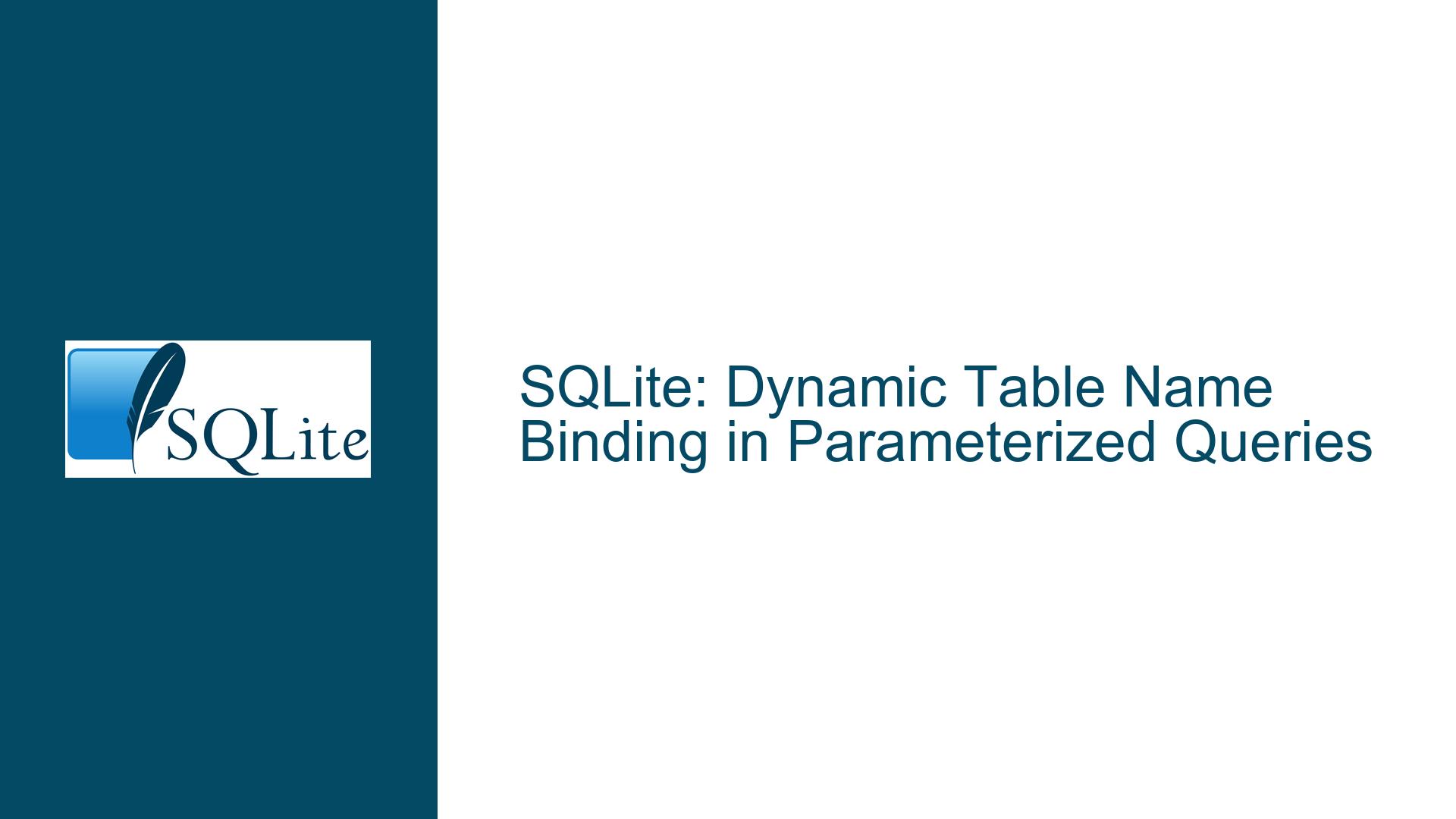SQLite: Dynamic Table Name Binding in Parameterized Queries
Issue Overview: Dynamic Table Name Binding in SQLite Queries
When working with SQLite, one common task is to insert data from one table into another. This operation is straightforward when the table names are static and known at the time of query construction. However, complications arise when the table name is dynamic and needs to be passed as a parameter. In such cases, developers often attempt to use parameterized queries to dynamically bind the table name, only to encounter syntax errors. This issue is particularly prevalent when using SQLite in conjunction with programming languages like R, Python, or others that support parameterized queries.
The core of the problem lies in the misunderstanding of how SQLite handles parameterized queries. SQLite allows for the binding of values (such as integers, strings, etc.) to placeholders in a query, but it does not support the binding of database object names (such as table names, column names, etc.). This limitation is not unique to SQLite; it is a common restriction across many relational database management systems (RDBMS). The error message "near ‘?’: syntax error" is a direct consequence of attempting to bind a table name to a placeholder, which SQLite interprets as a syntax violation.
The confusion often stems from the assumption that parameterized queries can be used to dynamically construct any part of a SQL statement. While parameterized queries are powerful tools for preventing SQL injection and improving query performance, they are not designed to handle the dynamic construction of database object names. This misunderstanding can lead to frustration, especially for developers who are new to SQLite or database programming in general.
Possible Causes: Misuse of Parameterized Queries for Dynamic Table Names
The primary cause of the issue is the misuse of parameterized queries to dynamically bind table names. Parameterized queries are designed to bind values, not database object names. When a developer attempts to bind a table name to a placeholder, SQLite interprets the placeholder as a value, leading to a syntax error. This is because SQLite expects the table name to be a static part of the SQL statement, not a bound parameter.
Another contributing factor is the lack of awareness about the limitations of parameterized queries. Many developers assume that parameterized queries can be used to dynamically construct any part of a SQL statement, including table names, column names, and other database object names. This assumption is incorrect and can lead to errors when attempting to execute such queries.
Additionally, the issue may be exacerbated by the use of programming languages or libraries that abstract away the details of SQL query construction. For example, in R, the dbExecute function is commonly used to execute SQL statements. While this function simplifies the process of executing queries, it does not provide explicit guidance on the limitations of parameterized queries. As a result, developers may inadvertently attempt to bind table names to placeholders, leading to errors.
Finally, the issue may be compounded by the lack of clear documentation or examples that demonstrate the correct use of parameterized queries in SQLite. While SQLite’s documentation provides a comprehensive overview of its features, it may not explicitly address the limitations of parameterized queries in the context of dynamic table name binding. This lack of clarity can lead to confusion and errors, especially for developers who are new to SQLite or database programming in general.
Troubleshooting Steps, Solutions & Fixes: Correctly Handling Dynamic Table Names in SQLite
To address the issue of dynamic table name binding in SQLite, developers must adopt alternative approaches that do not rely on parameterized queries. The following steps outline the correct way to handle dynamic table names in SQLite:
String Concatenation for Dynamic Table Names: The most straightforward approach to handling dynamic table names is to use string concatenation to construct the SQL statement. This involves building the SQL query as a string, with the table name inserted directly into the query. For example, in R, the query can be constructed as follows:
table_name <- "Uxxx" query <- paste0("INSERT INTO ", table_name, " SELECT * FROM portf_data;") dbExecute(mydb, query)This approach ensures that the table name is correctly inserted into the SQL statement, avoiding the syntax error caused by attempting to bind the table name to a placeholder.
Validation and Sanitization of Dynamic Table Names: When using string concatenation to construct SQL statements, it is crucial to validate and sanitize the dynamic table name to prevent SQL injection attacks. SQL injection is a security vulnerability that occurs when an attacker is able to manipulate the SQL query by injecting malicious code. To mitigate this risk, developers should validate the table name to ensure it conforms to expected patterns (e.g., alphanumeric characters, underscores, etc.) and sanitize it by escaping any special characters. In R, this can be done using the
dbQuoteIdentifierfunction:table_name <- "Uxxx" safe_table_name <- dbQuoteIdentifier(mydb, table_name) query <- paste0("INSERT INTO ", safe_table_name, " SELECT * FROM portf_data;") dbExecute(mydb, query)This approach ensures that the table name is safely inserted into the SQL statement, reducing the risk of SQL injection.
Using Prepared Statements with Static Table Names: If the table name is known at the time of query construction, developers can use prepared statements with static table names. Prepared statements are precompiled SQL statements that can be executed multiple times with different parameter values. While prepared statements do not support dynamic table names, they can be used to efficiently execute queries with static table names and dynamic values. For example, in R, a prepared statement can be created as follows:
query <- "INSERT INTO Uxxx SELECT * FROM portf_data;" dbExecute(mydb, query)This approach is useful when the table name is fixed and the query needs to be executed multiple times with different parameter values.
Dynamic SQL Generation with Conditional Logic: In some cases, the table name may need to be determined dynamically based on certain conditions. In such scenarios, developers can use conditional logic to generate the SQL statement. For example, in R, the table name can be determined based on a condition and then used to construct the query:
if (condition) { table_name <- "Uxxx" } else { table_name <- "Uyyy" } query <- paste0("INSERT INTO ", table_name, " SELECT * FROM portf_data;") dbExecute(mydb, query)This approach allows for the dynamic generation of SQL statements based on runtime conditions, while still avoiding the use of parameterized queries for table names.
Using Stored Procedures or Scripts: In more complex scenarios, developers can use stored procedures or scripts to handle dynamic table names. Stored procedures are precompiled SQL code that can be executed on the database server. While SQLite does not natively support stored procedures, developers can use scripts or external programs to achieve similar functionality. For example, in R, a script can be written to dynamically generate and execute SQL statements based on the table name:
generate_and_execute_query <- function(table_name) { query <- paste0("INSERT INTO ", table_name, " SELECT * FROM portf_data;") dbExecute(mydb, query) } generate_and_execute_query("Uxxx")This approach provides a flexible way to handle dynamic table names, especially in scenarios where the table name is determined by complex logic or external inputs.
Leveraging ORM (Object-Relational Mapping) Tools: For developers working with object-oriented programming languages, ORM tools can simplify the handling of dynamic table names. ORM tools abstract away the details of SQL query construction, allowing developers to work with database objects in a more intuitive way. While ORM tools may not directly support dynamic table names, they can be extended or customized to handle such scenarios. For example, in Python, the SQLAlchemy ORM can be used to dynamically construct SQL statements:
from sqlalchemy import create_engine, Table, MetaData engine = create_engine('sqlite:///mydb.sqlite') metadata = MetaData() table_name = "Uxxx" table = Table(table_name, metadata, autoload_with=engine) query = table.insert().from_select(None, table.select()) engine.execute(query)This approach leverages the power of ORM tools to handle dynamic table names, while still maintaining the benefits of parameterized queries for value binding.
Error Handling and Logging: When working with dynamic table names, it is important to implement robust error handling and logging mechanisms. This ensures that any issues related to dynamic table name binding are quickly identified and addressed. For example, in R, developers can use the
tryCatchfunction to handle errors and log relevant information:tryCatch({ table_name <- "Uxxx" query <- paste0("INSERT INTO ", table_name, " SELECT * FROM portf_data;") dbExecute(mydb, query) }, error = function(e) { message("Error executing query: ", e$message) # Log the error or take corrective action })This approach helps to ensure that any errors related to dynamic table name binding are properly handled, reducing the risk of data corruption or other issues.
Testing and Validation: Finally, it is essential to thoroughly test and validate any SQL statements that involve dynamic table names. This includes testing the SQL statement with different table names, validating the results, and ensuring that the query performs as expected. In R, developers can use unit testing frameworks like
testthatto automate the testing process:library(testthat) test_that("Dynamic table name binding works correctly", { table_name <- "Uxxx" query <- paste0("INSERT INTO ", table_name, " SELECT * FROM portf_data;") expect_silent(dbExecute(mydb, query)) })This approach ensures that the SQL statement is correctly constructed and executed, even when the table name is dynamically determined.
In conclusion, the issue of dynamic table name binding in SQLite arises from the misuse of parameterized queries to bind database object names. By understanding the limitations of parameterized queries and adopting alternative approaches, developers can effectively handle dynamic table names while maintaining the security and performance benefits of parameterized queries. The steps outlined above provide a comprehensive guide to troubleshooting and resolving this issue, ensuring that SQLite queries involving dynamic table names are correctly constructed and executed.






